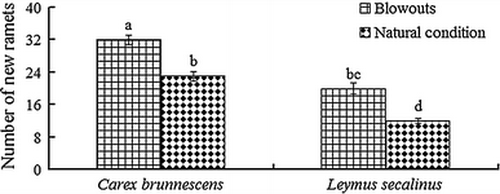Remediation of blowouts by clonal plants in Maqu degraded alpine grasslands of northwest China
Updatetime:2017-04-13From:
【Enlarge】【Reduce】
The sand-fixation of plants is considered to be the most effective and fundamental measure in desertification control in many arid and semi-arid regions. Carex brunnescens (Carex spp) andLeymus secalinus (Leymus), two perennial clonal herbs native to the Maqu degraded alpine areas of northwest China, are dominant and constructive species in active sand dunes that have excellent adaptability to fix sand dunes found to date. In order to study the ability and mechanism of sandland blowout remediation by two clone plants C. brunnescens and L. secalinus, the artificially emulated blowouts were set up in the populations of two clonal plants in the field. The results showed that both C. brunnescens and L. secalinus produced more new ramets in the artificially emulated blowouts than in the natural conditions, suggesting that the two clonal plants had strong ability in blowouts remediation; while the biomass, number of leaves and height of new ramets in the artificially emulated blowouts were less than in the natural conditions due to the restriction of poor nutrients in the artificially emulated blowouts. The ability of blowouts remediation by C. brunnescens was stronger than L. secalinus, as it generated more new ramets than L. secalinus in the process of blowouts remediation. The new ramets of L. secalinus in the blowouts remediation were mainly generated by the buds in the rhizomes which spread from outside of the blowouts; while those of C. brunnescens were generated both by the buds in the rhizomes which spread from outside, and by the buds in the rhizomes inside which were freed from dormancy in the deeper soil under wind erosion conditions. These findings suggest that through rapid clonal expansion capability, C. brunnescens and L. secalinus exhibited strong ability in blowouts remediation which can be one of the most effective strategies to restore and reconstruct degraded vegetations in Maqu alpine areas of northwest China.
This research achievement is published on the Journal of Plant Research.
Keywords:C. brunnescens; Clonal plants; L. secalinus; Maqu alpine regions; Perennial herb; Blowouts remediation

Fig. Number of newly generated ramets of Carex brunnescens and Leymus secalinus in the artificially emulated blowouts and natural conditions. Values indicate the mean ± SD (n = 6) and bars indicate SD. Different letters in each column indicate significant difference at P < 0.05 (Duncan test)





